This document summarizes a case study about collusion between a journalist from the Slovak daily Pravda, Vanda Vavrova, and a top Slovak politician and Member of Parliament, Robert Kaliňák. The study examines wiretapped phone conversations that show Kaliňák trying to pressure Vavrova into publishing damaging information about one of his political rivals. While the media criticized the wiretapping, they downplayed the collusion between the journalist and politician. The document provides context on media ownership in Slovakia and analyzes the content of the conversations, as well as the initial media coverage of the scandal.
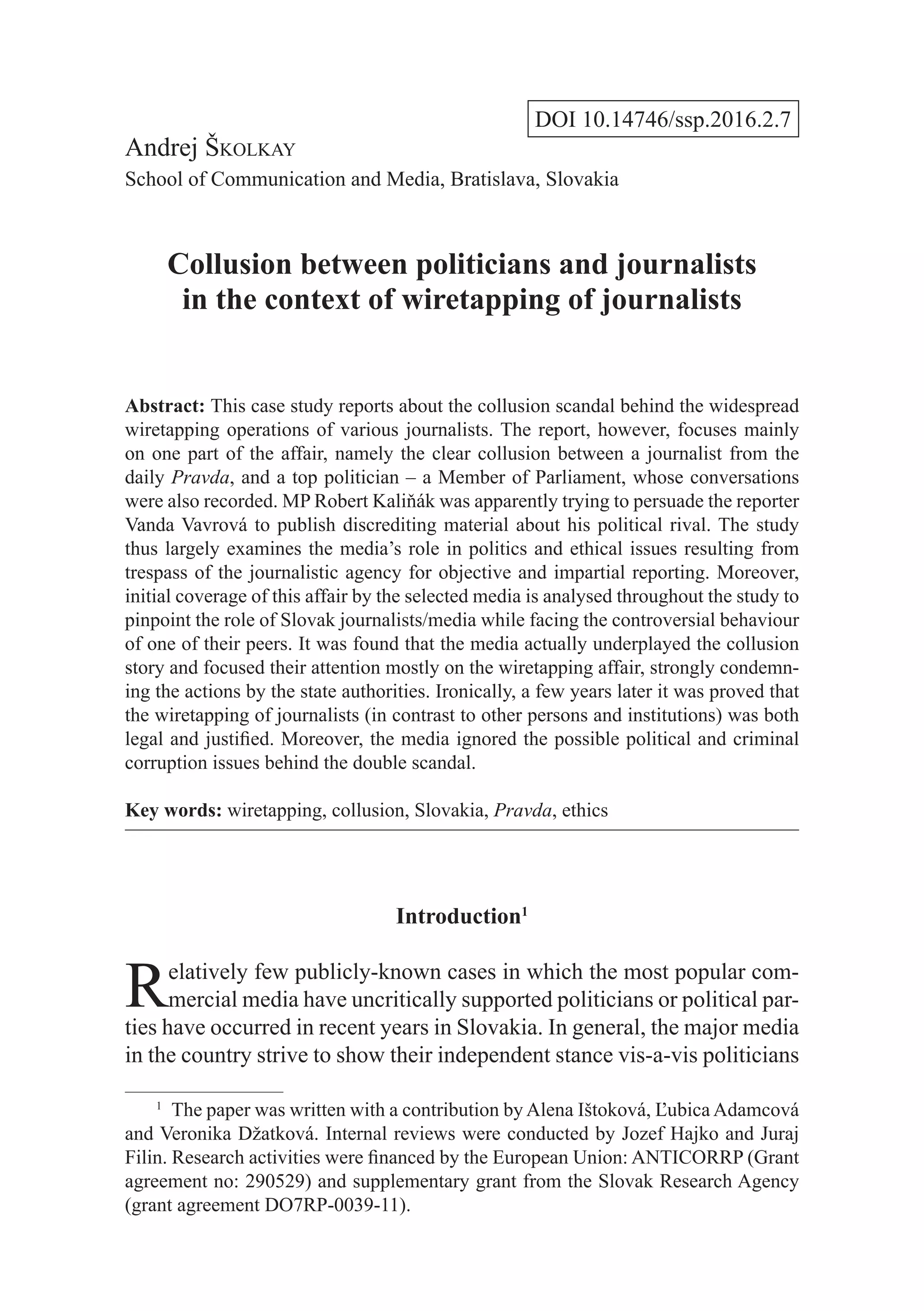
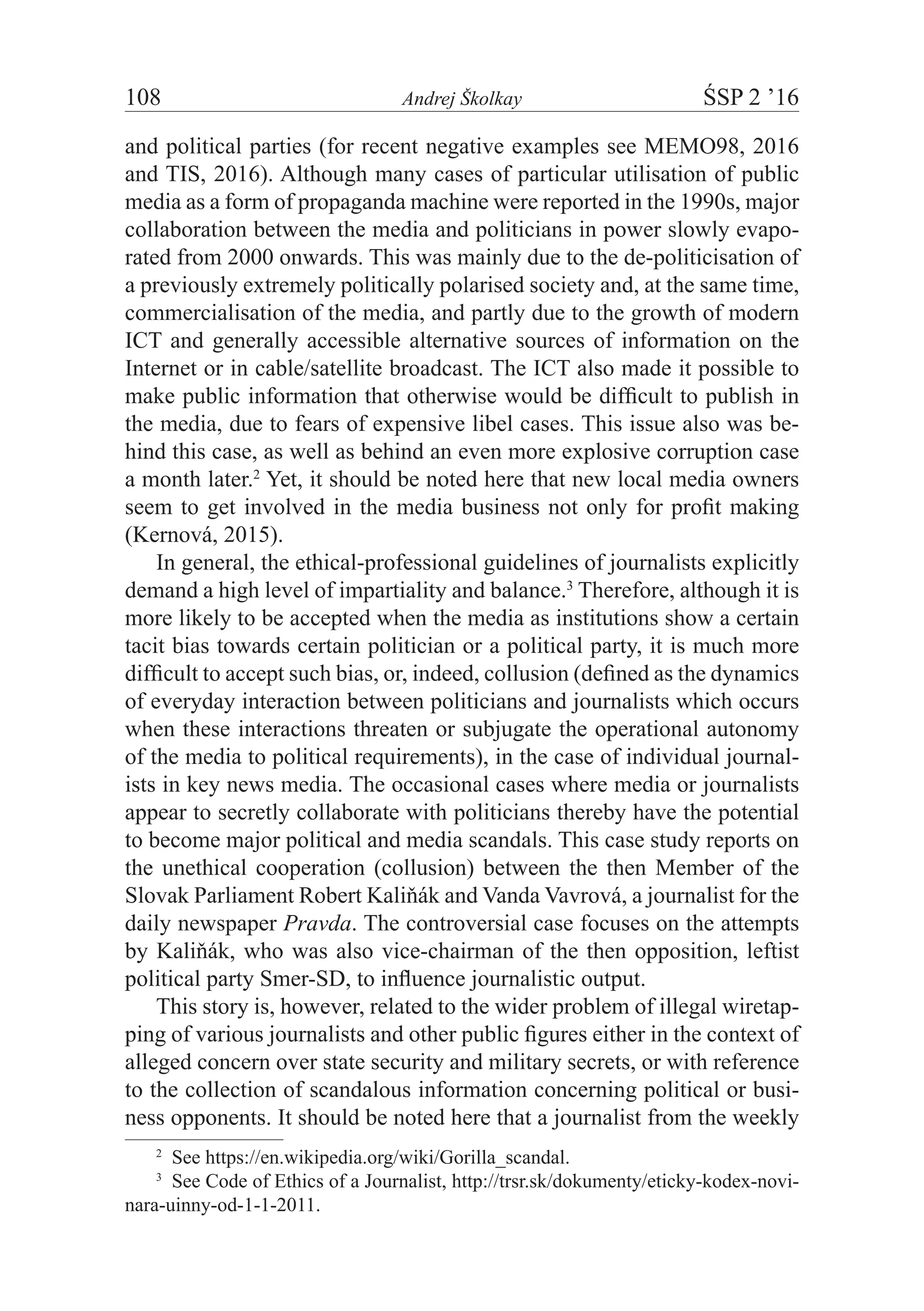
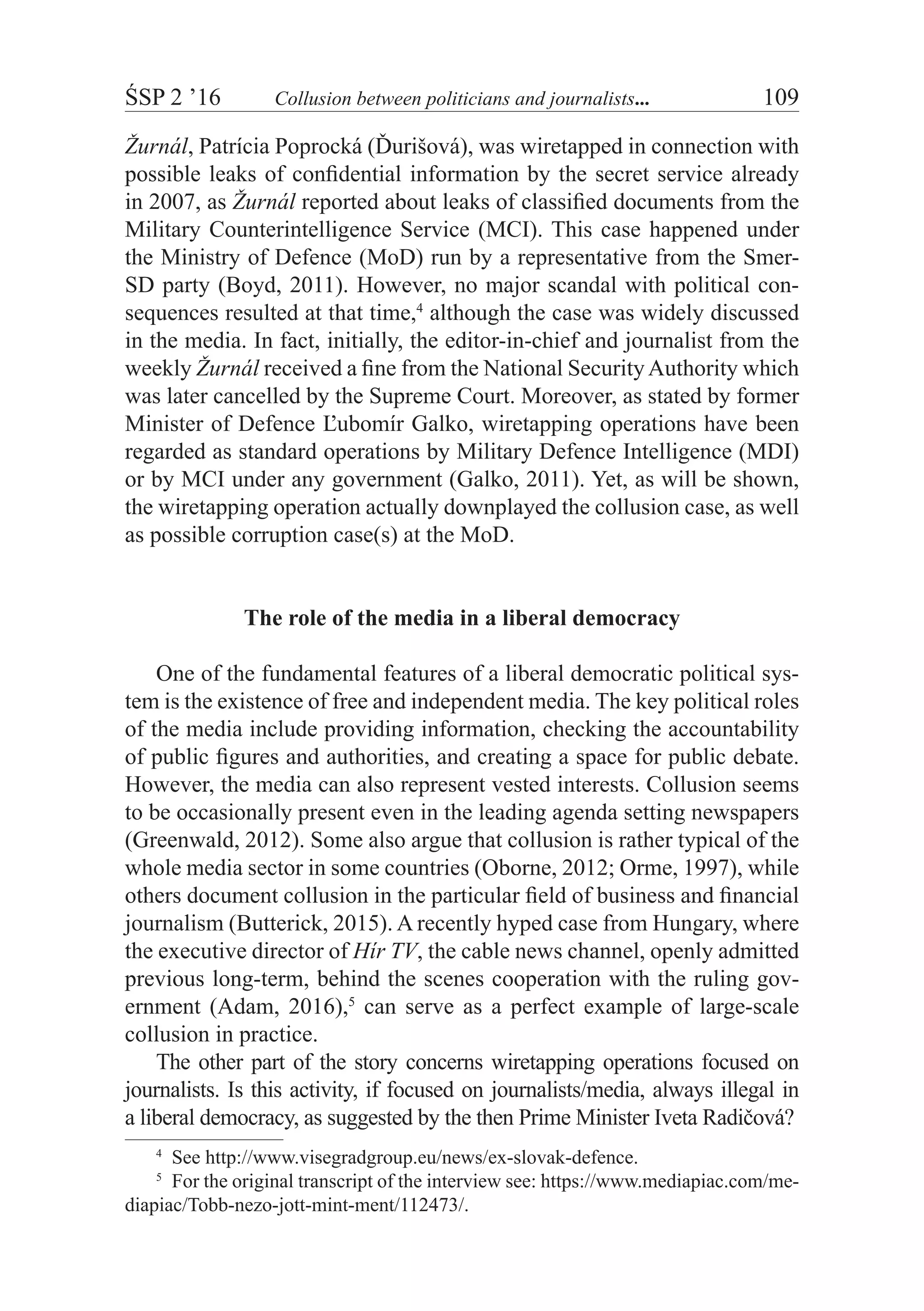
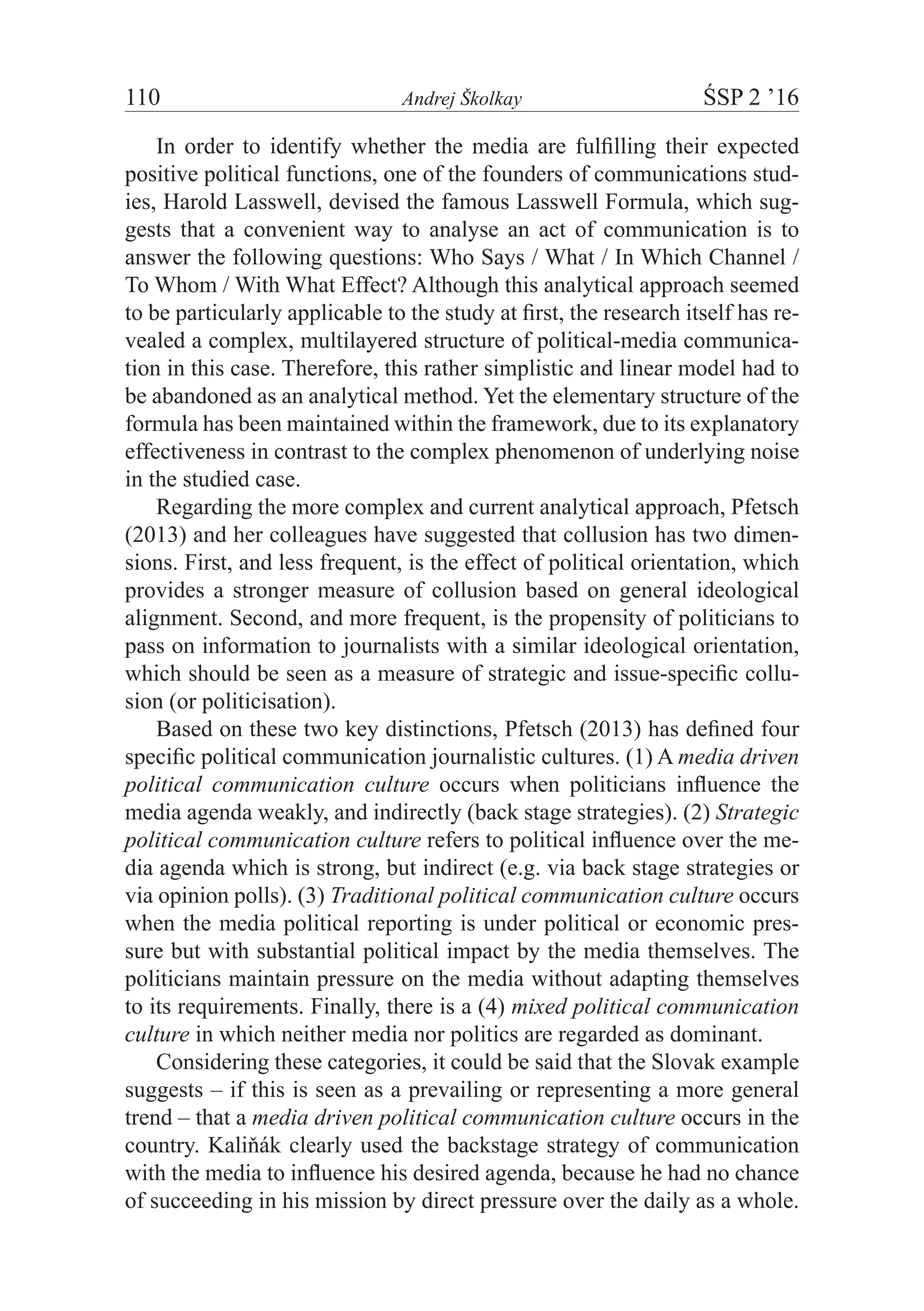
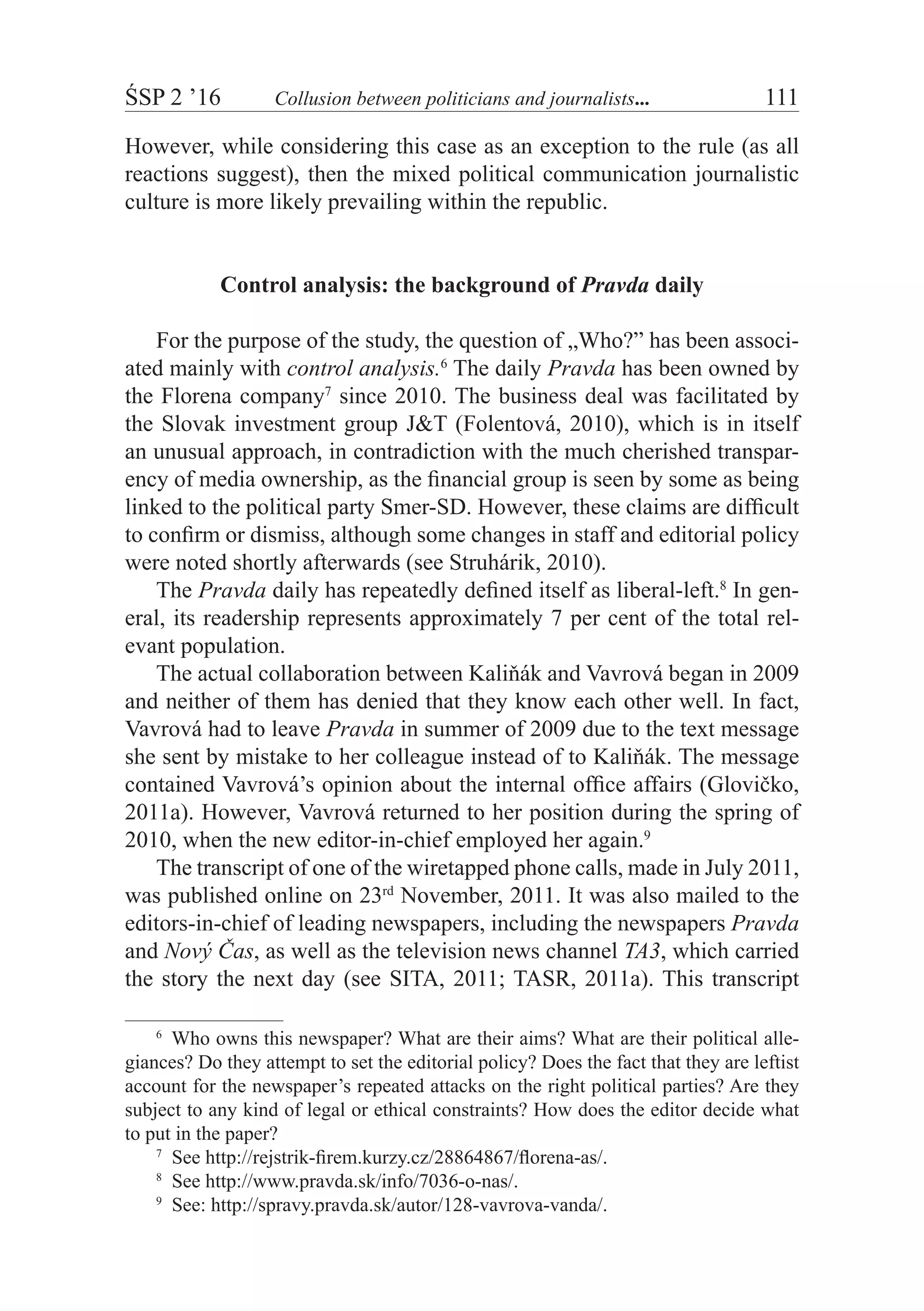
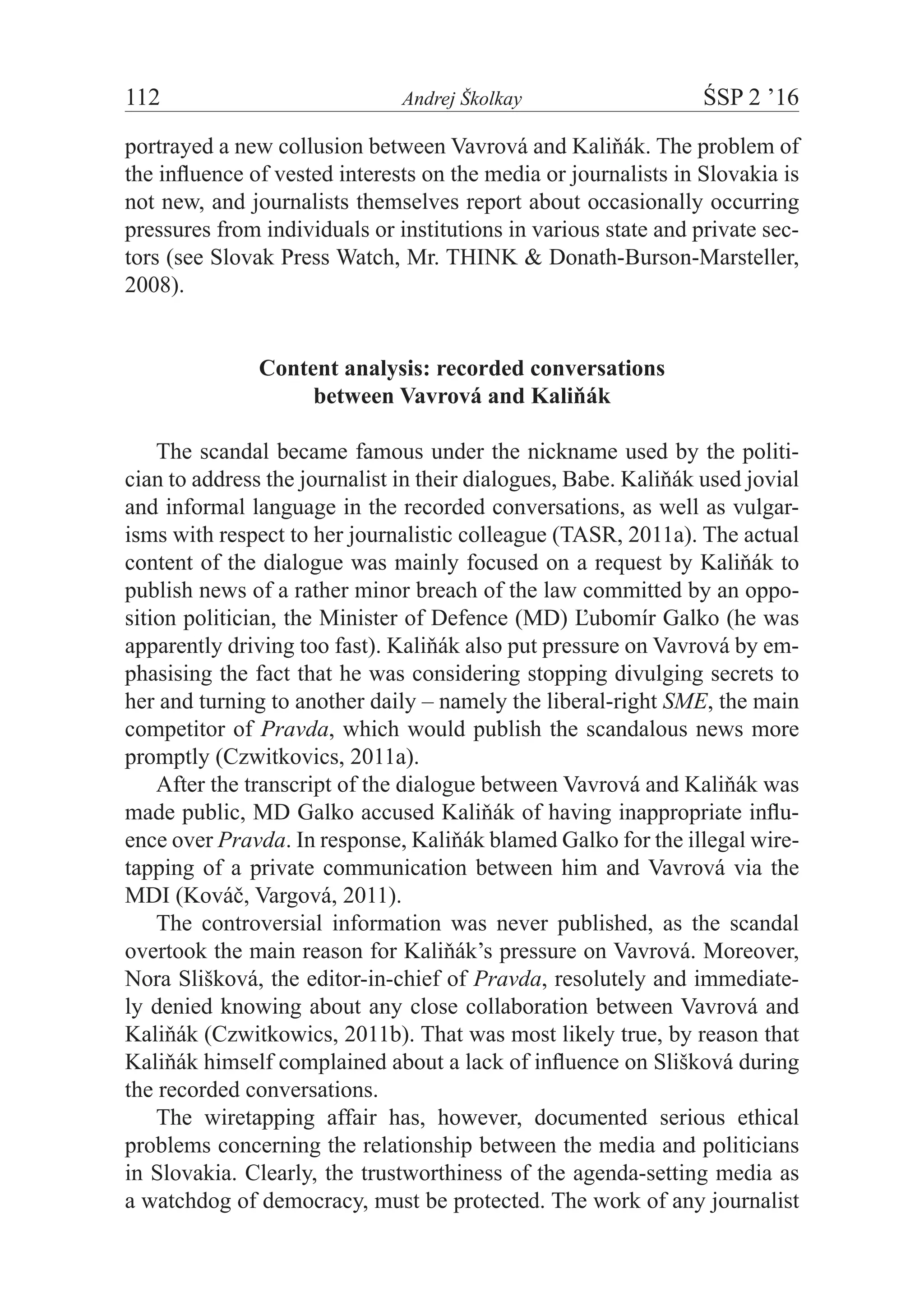
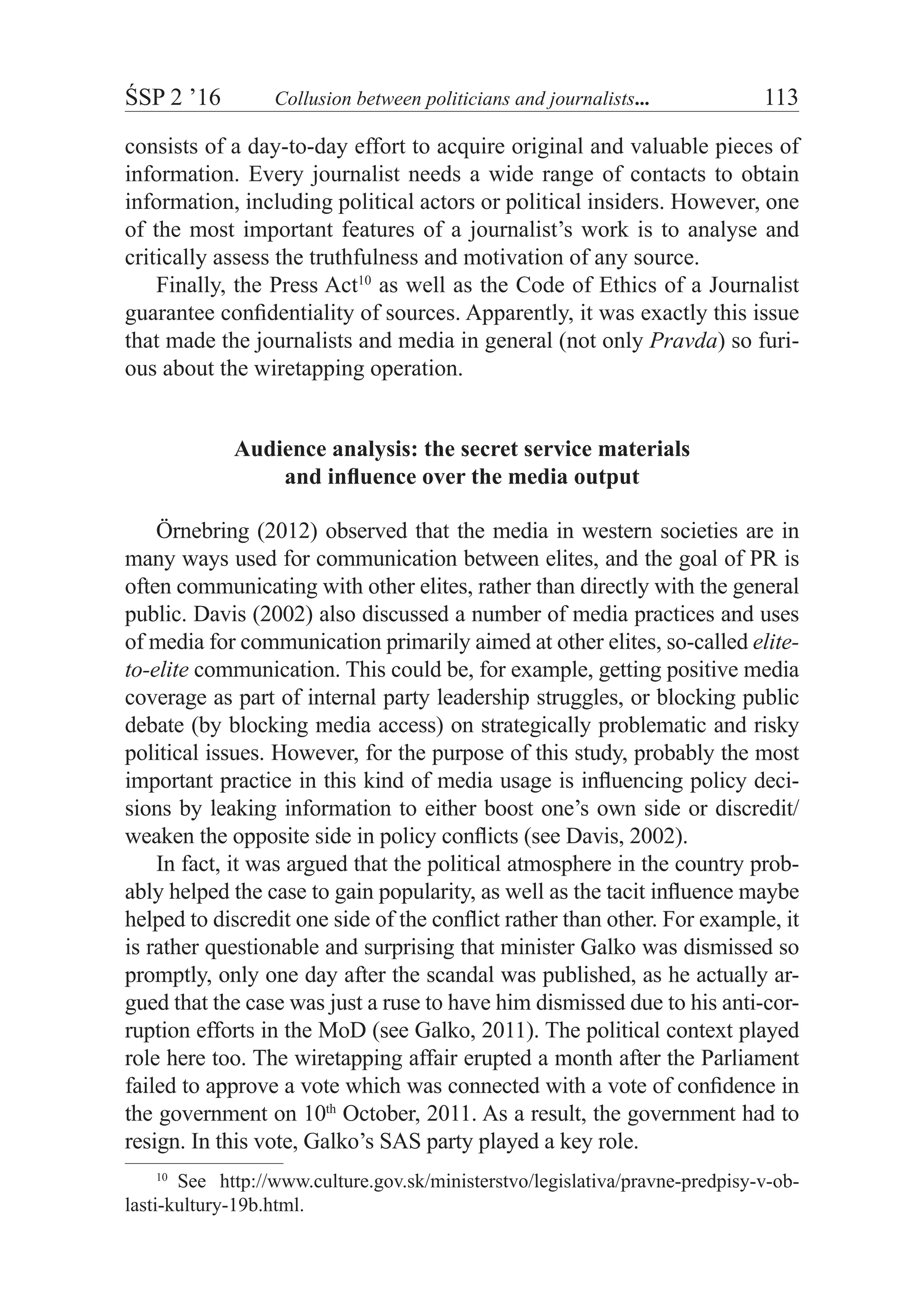

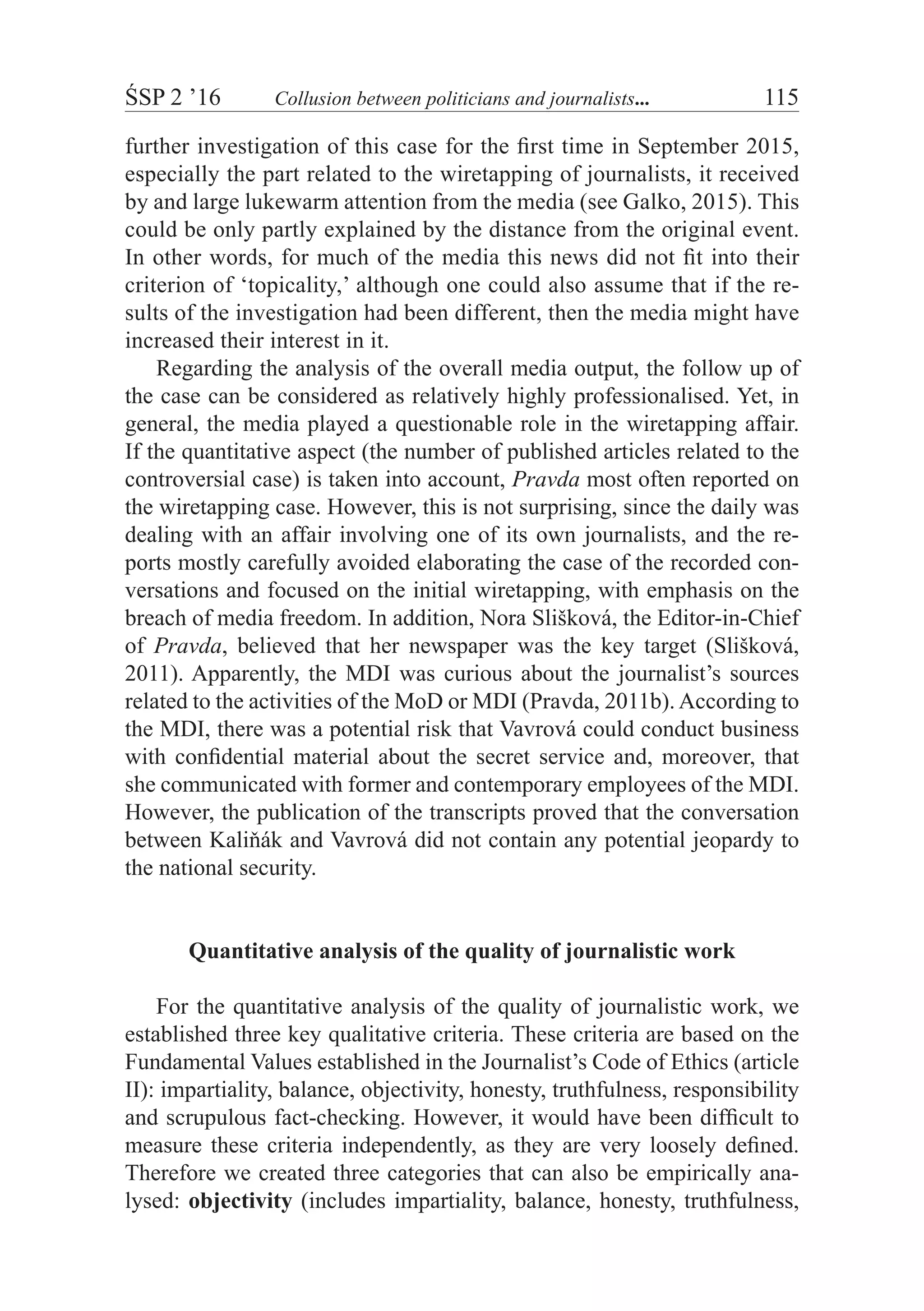

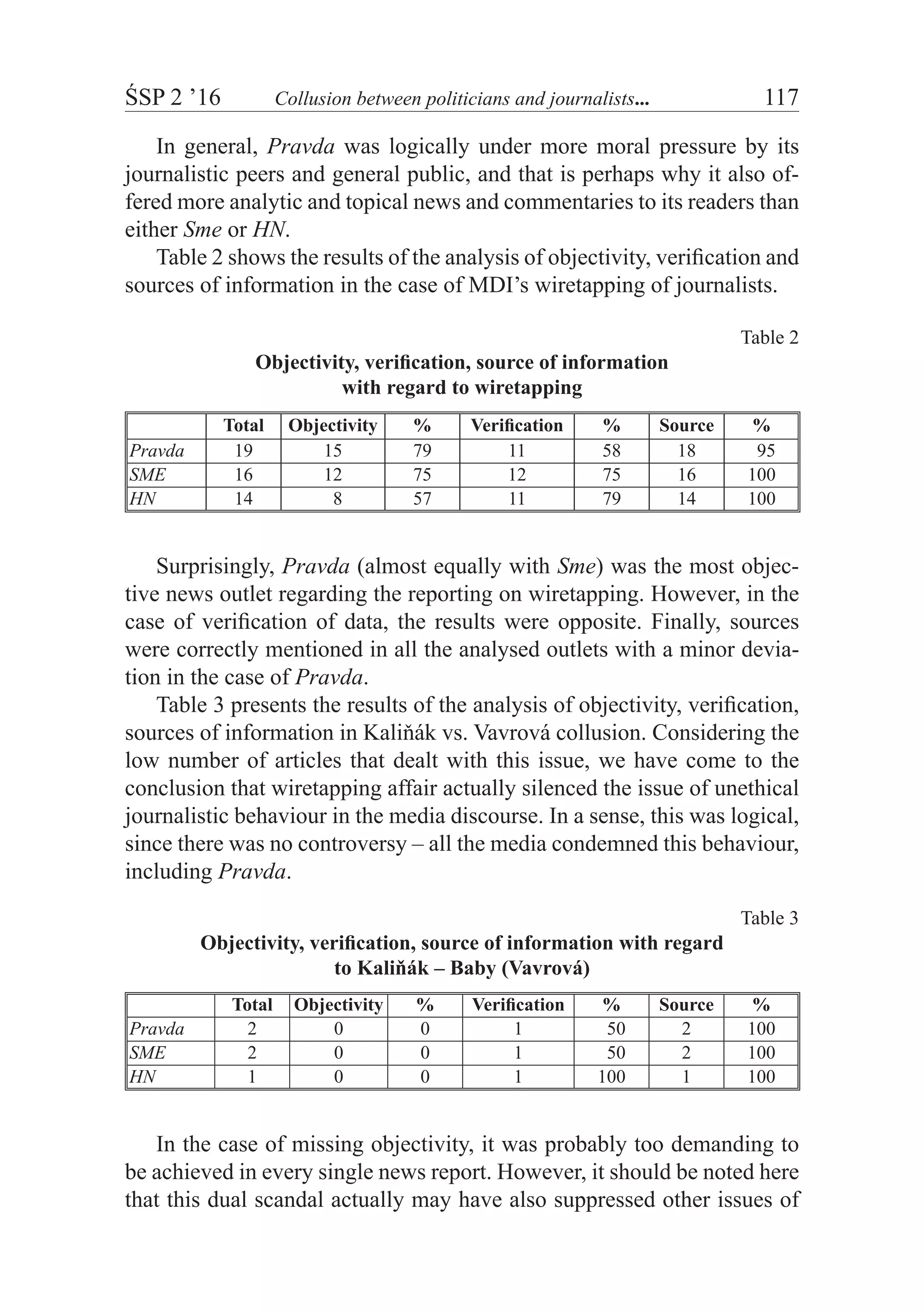
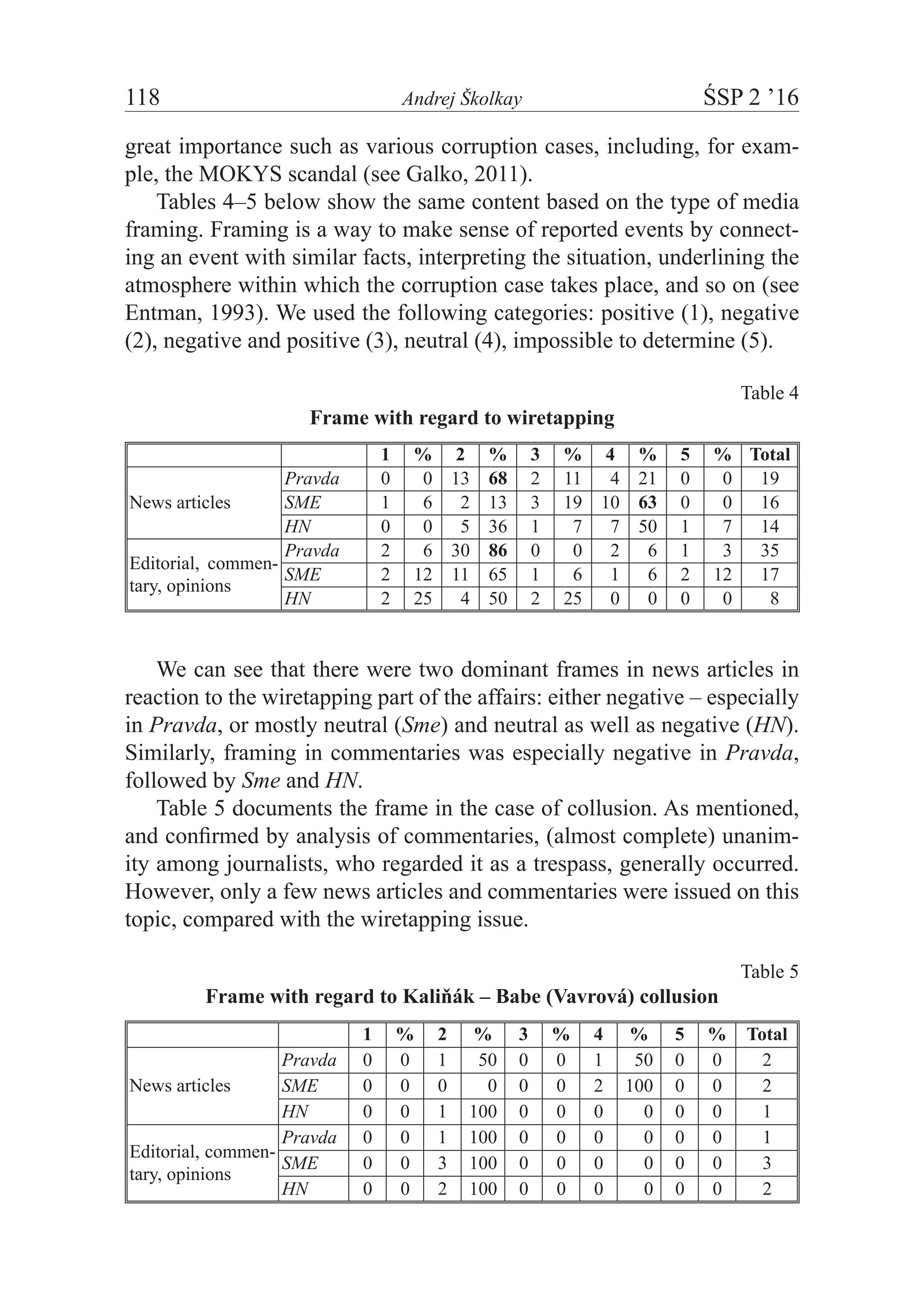
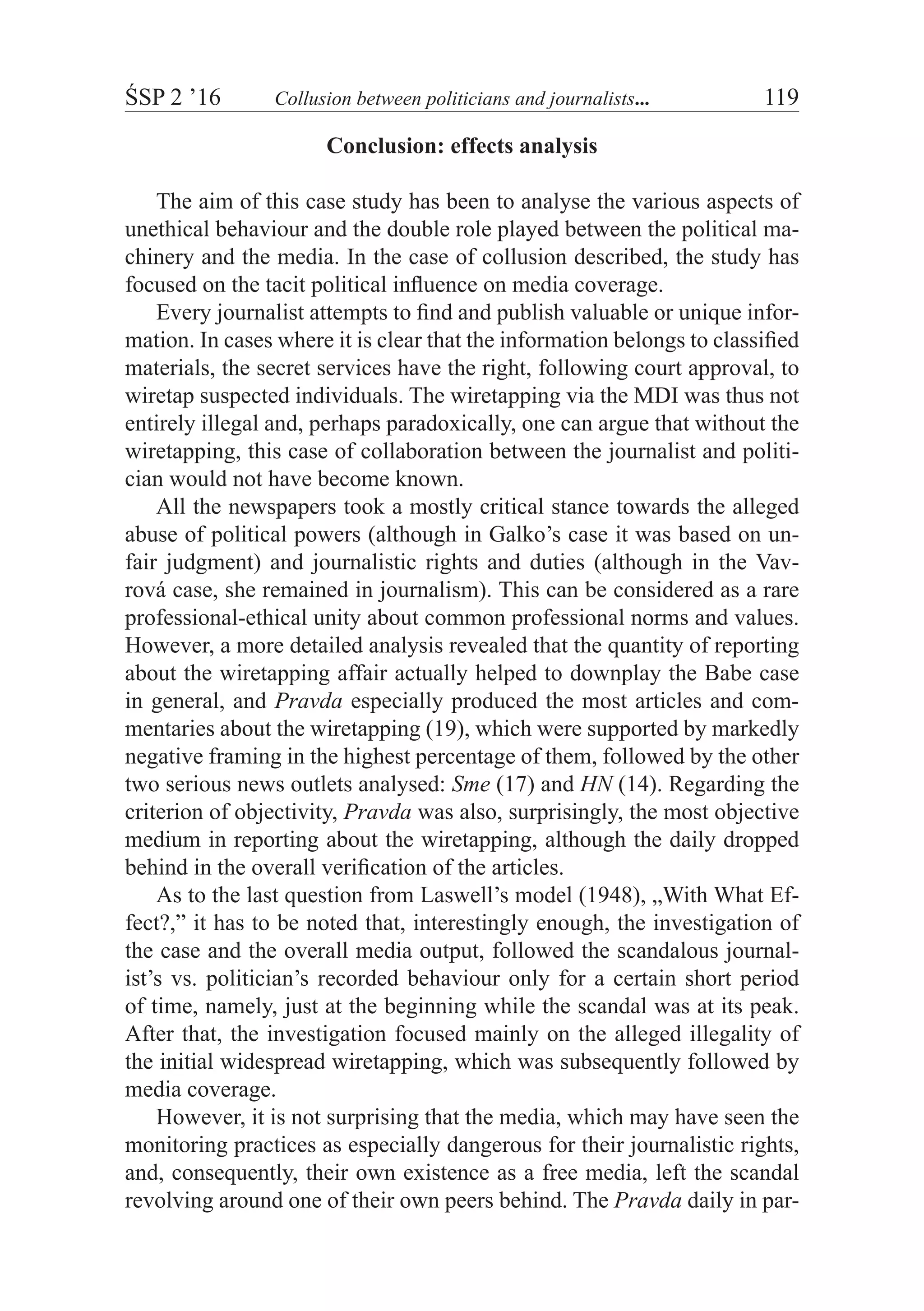

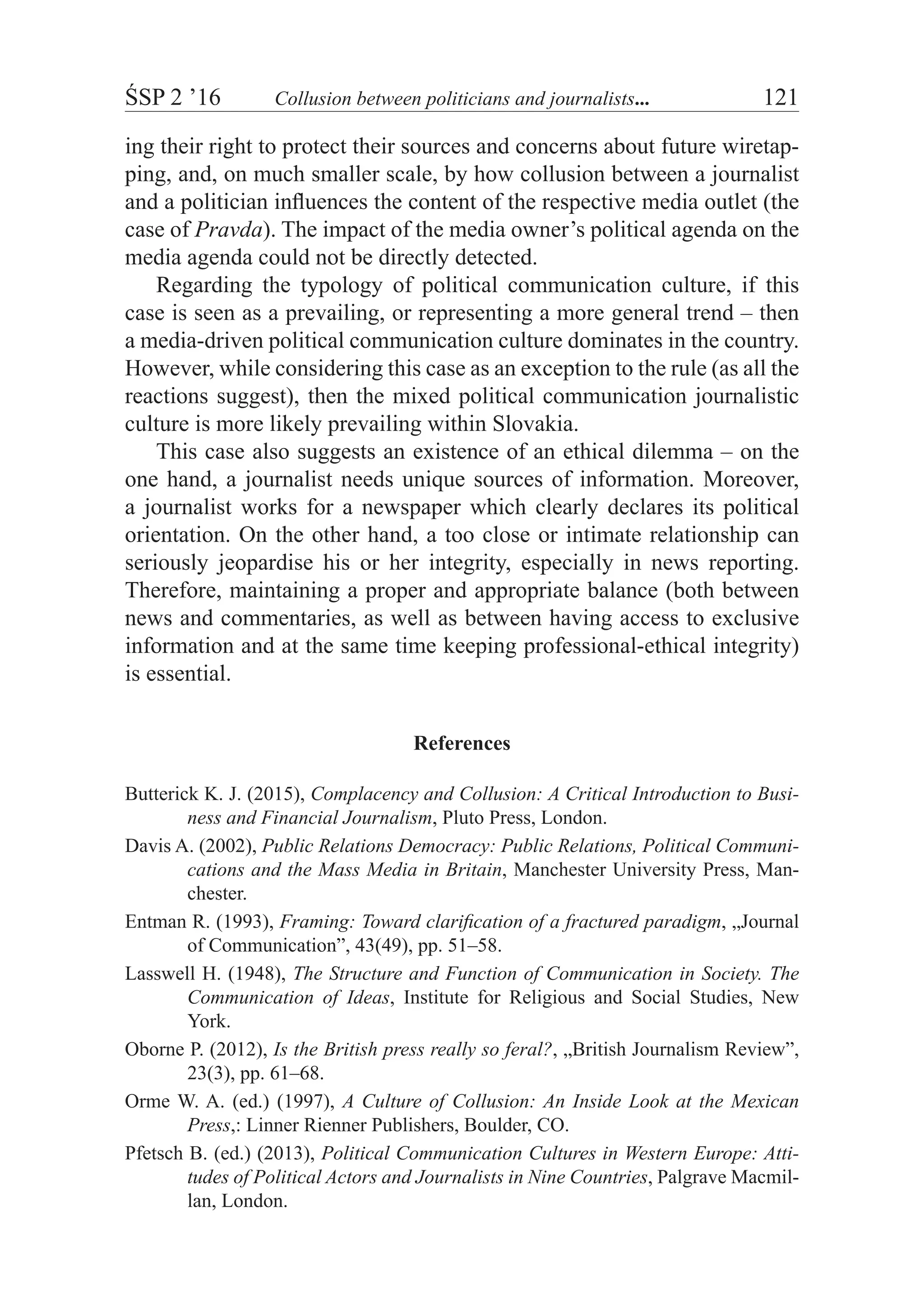
![122 Andrej Školkay ŚSP 2 ’16
Örnebring H. (2012), Clientelism, Elites, and the Media in Central and Eastern Eu-
rope, „International Journal of Press/Politics”, 17(4), pp. 497–515.
Slovak Press Watch, Mr. THINK & Donath-Burson-Marsteller (2008), Názory
slovenských novinárov na vybrané otázky mediálneho prostredia na Slov-
ensku. Výsledná správa z prieskumu (Opinions of Slovak Journalists on Se-
lected Issues from the Media Environment in Slovakia), http://www.dbm.cz/
pfile/2Vysledna%20sprava.pdf.
Online news websites:
Adam Ch. (2016, February 7), Of droids and slaves – The media in the Orbán regime,
“Hungarian Free Press”, http://hungarianfreepress.com/2016/02/07/of-droids-
and- slaves-media-in-the-orban-regime/.
Boyd J. (2011, November 23), Prime Minister and Defence Ministry Also Tapped,
http://www.thedaily.sk/prime-minister-and-defence-ministry-also-tapped/.
Bukovský M. (2011, November 24), Foto: Internetom sa šíria prepisy rozhovorov
Roba s novinárkou [Photo: Transcriptions of Robo’s conversations with
a journalist are spreading throughout the Internet], aktuality, http://www.ak-
tuality.sk/clanok/197635/internetom-sa-siria-prepisy-rozhovorov-roba-s-no
vinarkou/.
Czwitkowics T. (2011a, November 24), Smer má v Pravde údajne kontaktnú osobu
[The Smer allegedly has a liason person], “Mediálne.trend”, http://medialne.
etrend.sk/tlac/smer-ma-v-pravde-udajne-kontaktnu-osobu.html.
Czwitkowics T. (2011b, November 25), Slišková: Konšpirácie sú smiešne [Slišková:
Conspiracies are funny], “Mediálne.trend”, http://medialne.etrend.sk/tlac/
sliskova-konspiracie-su-smiesne.html.
Folentová V. (2010, March 3), J&T sľubuje redakcii Pravdy slobodu [J&T promised
freedom to the Pravda daily], “Sme”, http://www.sme.sk/c/5267576/jt-slubu-
je-redakcii-pravdy-slobodu.html.
Galko Ľ. (2011, December 3), Hry tieňového šéfredaktora Kaliňáka [Power-games
of the opposition editor-in-chief Kaliňák], “blog.Sme”, http://lubomirgalko.
blog.sme.sk/c/282295/Hry-tienoveho-sefredaktora-Kalinaka.html.
Galko Ľ. (2015, September 9), Liberálny boh mi je svedkom, že nemám veľké uši
[The Liberal God is my witness that I do not wiretap people], “blog.Sme”,
http://lubomirgalko.blog.sme.sk/c/387603/liberalny-boh-mi-je-svedkom-ze-
nemam-velke-usi.html.
Glovičko J. (2011, November 23), Kaliňák hovoril redaktorke Pravdy, čo má robiť
[Kaliňák was instructing Pravda’s journalist about what has to be done],
“Sme”, http://www.sme.sk/c/6152656/kalinak-hovoril-redaktorke-pravdy-
co-ma-robit.html#ixzz3gumCFDjS.
Greenwald G. (2012, August 29), Correspondence and collusion between the New
York Times and the CIA, “The Guardian”, http://www.theguardian.com/com-
mentisfree/2012/aug/29/correspondence-collusion-new-york-times-cia.](https://image.slidesharecdn.com/andrejskolkacollusionbetweenpoliticiansandjournalists-190806101118/75/Collusion-between-politicians-and-journalists-in-the-context-of-wiretapping-of-journalists-16-2048.jpg)
![ŚSP 2 ’16 Collusion between politicians and journalists... 123
HN (2011a, November 21), Galkovi ľudia odpočúvali novinárov. Minister sa bráni
[Galko’s people were wiretapping journalists, The minister defends himself],
“HN online”, http://hn.hnonline.sk/slovensko-119/galkovi-ludia-odpocuvali-
novinarov-minister-sa-brani-473904.
HN (2011b, November 22), Novinári písali o čistkách. Začali ich odpočúvať [The
journalists were writing about the clear-outs. They started to monitor them],
“HN online”, http://hn.hnonline.sk/slovensko-119/novinari-pisali-o-cistkach-
zacali-ich-odpocuvat-474043.
Kernová M. (2015. April 22), Penta si z novinárov urobila atómový kufrík [Penta
has made a Nuclear Deterrence Tool of Journalists], https://dennikn.sk/blog/
penta-si-z-novinarov-urobila-atomovy-kufrik/.
Kováč P., Vargová J. (2011, November 24), Kaliňák riadi Pravdu, tvrdí Galko. On
to však odmieta [Kaliňák controls Pravda, says Galko. However, he denies
it], “aktuality”, http://www.aktuality.sk/clanok/197646/kalinak-riadi-pravdu-
tvrdi-galko-on-to-vsak-odmieta/.
MEMO98 (2016), Prezentácia politických predstaviteľov a subjektov pred voľbami do
NR SR (13.2.–28.2.2016), [Presentation of Politicians and Parties during the
Election Campaign to Parliament (13.2.–28.2.2016)], http://www.memo98.
sk/index.php?base=data/spravy/2016/1456838367.txt.
Petková Z., Kern M., Tódová M. (2011, November 21), Pravica vidí v odpočúvaní
návrat Mečiara [The right wing sees the return of Mečiar in the wiretapping],
“Sme”, http://www.sme.sk/c/6149532/pravica-vidi-v-odpocuvani-navrat-
meciara.html#ixzz3guuugFnp.
Pravda (2011a, November 22), Minister obrany Galko skončil [The Minister of De-
fence Galko had to leave office], “Pravda”, http://spravy.pravda.sk/domace/
clanok/172461-minister-obrany-galko-skoncil/.
Pravda (2011b, November 22), Ako spravodajská služba odôvodnila odpočúvanie,
pozrite si fotokópiu [What reason did the intelligence service give for wire-
tapping, see the photocopy], “Pravda”, http://spravy.pravda.sk/domace/
clanok/172456-ako-spravodajska-sluzba-odovodnila-odpocuvanie-pozrite-
si-fotokopiu/.
SITA (2011, November 24), Galko vracia úder: Kaliňák priznal, že riadi Pravdu!
[Galko counters: Kaliňák has admitted that he has control over Pravda!], “top-
ky”, http://www.topky.sk/cl/100535/1292112/Galko-vracia-uder--Kalinak-
priznal--ze-riadi-Pravdu-.
SITA & TASR (2011, November 25), Galko: Dôstojník VOS odmietol ísť na detektor
lži [Galko: The MDI officer refused to undergo a lie-detector test], “Sme”,
http://www.sme.sk/c/6155418/galko-dostojnik-vos-odmietol-ist-na-detektor-
lzi.html#ixzz3gusCpomM.
Slišková N. (2011, November 20), Denník Pravda odpočúvali Galkovi ľudia [The
Pravda daily was wiretapped by Galko’s people], “Pravda”, http://spravy.
pravda.sk/domace/clanok/172434-dennik-pravda-odpocuvali-galkovi-ludia/.](https://image.slidesharecdn.com/andrejskolkacollusionbetweenpoliticiansandjournalists-190806101118/75/Collusion-between-politicians-and-journalists-in-the-context-of-wiretapping-of-journalists-17-2048.jpg)
![124 Andrej Školkay ŚSP 2 ’16
Struhárik F. (2010, May 23), Fico už má asi vlastný denník. Denník Pravda (Fico
probably owns his own daily newspaper. Daily Pravda), http://www.butlava-
vrba.net/2010/05/fico-uz-asi-ma-vlastny-dennik-dennik.html.
Stupňan I. (2015, April 29), Galkovi tajní sú tesne pred obžalobou [Galko’s secret
agents are close to being prosecuted], “Pravda”, http://spravy.pravda.sk/dom-
ace/clanok/353467-galkovi-tajni-su-tesne-pre-obzalobou/?sc=art-357234.
TASR (2011a, November 24), Kaliňák: Nie je podstatný rozhovor s novinárkou, ale
obludnosť Galka [Kaliňák: The conversation with the journalist is not im-
portant, but the monstrosity of Galko is], “Pravda”, http://spravy.pravda.sk/
domace/clanok/172494-kalinak-nie-je-podstatny-rozhovor-s-novinarkou-ale-
obludnost-galka/.
TASR(2011b,November23),Zriadilišpeciálnytímnaprešetreniekauzyodpočúvania,
povedie ho Trnka [A special team for investigating the wiretapping case was
established, Trnka will be in charge], “Pravda”, http://spravy.pravda.sk/dom-
ace/clanok/172475-zriadili-specialny-tim-na-presetrenie-kauzy-odpocuva-
nia-povedie-ho-trnka/.
TASR & SITA (2011, November 25), Politici ku kauze „bejby” prepisov: Kaliňák
mal odstúpiť už dávno! [Politicians on the transcripts of the „babe” case:
Kaliňák should have resigned a long time ago!], “topky”, http://www.topky.
sk/cl/100371/1292118/Politici-ku-kauze--bejby--prepisov--Kalinak-mal-o
dstupit-uz-davno-.
TIS (2016, February 2), TA3 a Pravda podržali vládu aj pri štrajku učiteľov [TA3
and Pravda hold the government line even during the teachers’ strike], http://
transparency.blog.sme.sk/c/401987/ta3-a-pravda-podrzali-vladu-aj-pri-stra-
jku-ucitelov.html.](https://image.slidesharecdn.com/andrejskolkacollusionbetweenpoliticiansandjournalists-190806101118/75/Collusion-between-politicians-and-journalists-in-the-context-of-wiretapping-of-journalists-18-2048.jpg)